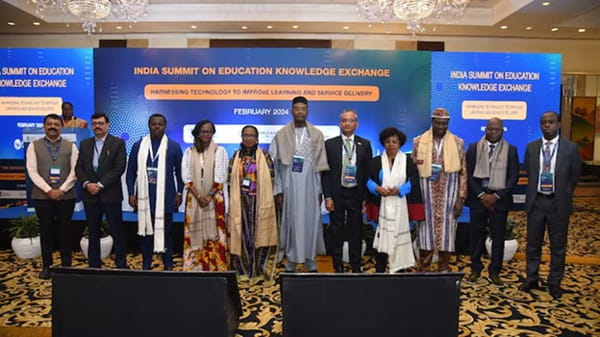
An Indian Army officer testing a VR training simulator. | Tecknotrove
In its second part, NatStrat’s Long Paper on AI asserts that India enjoys several natural advantages in the field of AI, and catalogues the major initiatives and legislations that have been passed to leverage these advantages.
ACKNOWLEDGEMENTS
This Paper is the outcome of consultations hosted by the Convenor of NatStrat, Pankaj Saran, with a group of experts in the tech, finance and AI space over many months. They are Sharad Sharma, co-founder of iSPIRT Foundation, a non-profit technology think-tank that has conceptualized India Stack, Health Stack and other digital public goods; Sanjay Anandaram, a Council member of iSPIRT, Executive Committee member of IIIT Bangalore-housed Mosip.io, the world’s largest Digital Public Goods deployed initiative, and part of the THINK20 initiative under the Italian Presidency of the G20 in 2021; Surya Kanegaonkar, a commodities trader and columnist based in Switzerland who has held key roles in the natural resources sector, working for an investment bank and utilities; and another expert who joined without attribution. NatStrat Researchers Siddhant Hira and Prateek Kapil coordinated the consultation process and editing of the paper.
Disclaimer:The views projected in the Paper are exclusively those of NatStrat and do not necessarily reflect the views of individual members or the group.
India, with its unique challenges and opportunities, must chart its own course. AI can benefit multiplesectors in India. The main ones are:
Socio-economic development: In areas like education, healthcare, financial services, agriculture, justice, and other areas by providing high quality, personalised, interactive content, enhancing the productivity of providers (making up for the shortfall of teachers and care providers), personalised agriculture and even for efficient dispensing of judicial cases.
National Security: Military, space, cybersecurityand the conduct of elections.
Manufacturing: Enhancing productivity and efficiency (for example, automation and quality control – China will provide competition to Indian exports from AI-enabled automation and quality control).
Economic: Indian companies will benefit by improving service, productivity, high value adds, industrial efficiency, owning IP and by being part of the digital supply chain. This market power can make Indian AI solutions cheap and deepen reach across sectors.
Geopolitical benefits: India will be able to provide know-how and deployment to other countries, partner with the Global North and deliver solutions to the Global South.
Cognitive Capital: Soft power.
Socio-Cultural: Protect and promote our values, beliefs and society.
Healthcare: Applications such as predictive diagnosis, improving patient care and medical image analysis.
Agriculture: Crop yield prediction, disease detection and precision farming.
Infrastructure and Urban Planning: Traffic management, waste disposal and sustainable city planning.
Financial Services: Preventing fraud, optimizing asset management and customizing client experiences through AI.
Education: Personalizing learning experiences and optimizing administrative processes.
INDIA’S JOURNEY SO FAR
A) Major Initiatives/Missions
● 1986 – Initiation of the Knowledge Based Computer Systems (KBCS) project, marking India's first major AI research programme.
● 1988 – Establishment of C-DAC (Centre for Development of Advanced Computing) to boost supercomputing capabilities, indirectly supporting AI research.
● 2014 – Digital India initiative which emphasized the importance of emerging technologies, including AI.
● 2018 – National Strategy for Artificial Intelligence by NITI Aayog. It laid out India's approach to AI, identifying key sectors like healthcare, agriculture, education, smart cities, and transportation for national priority in AI innovation and deployment.
● 2020 – Unveiling of the National AI Portal of India, a one stop digital platform for AI related developments in India.
● 2020 – India became a founder member of the Global Partnership on Artificial Intelligence (GPAI). Built around a shared commitment to the OECD Recommendation on Artificial Intelligence, GPAI brings together engaged minds and expertise to foster international cooperation. India became chair and hosted the ‘Global IndiaAI Summit’ in July 2024.
● 2021 – Launch of the National Programme on Artificial Intelligence (NPAI). The objective was to establish a comprehensive programme for leveraging transformative technologies to foster inclusion, innovation and adoption for social impact. NPAI encompasses four broad pillars of the AI ecosystem, i.e. Skilling in AI, Responsible AI, Data Management Office and Setting up the National Centre on Al.
● 2022 – Initiative on responsible AI for Youth Initiative of launched by MeitY in collaboration with Intel India to develop AI centric skills among school children.
● 2023 – AI for India 2.0 launched to promote AI education and skill development by offering free online training on AI duly accredited by National Council for Vocational Education and Training and IIT Madras.
● 2023 – Launch of Skill India Digital Hub to facilitate digital access to skill development, including preparing the Indian workforce for Industry 4.0 by offering futuristic courses such as Python with Advanced Artificial Intelligence (AI), Artificial Intelligence Foundation, Generative AI, building classical Machine Learning Models, among many others.
● 2024 – The Indian Cabinet approved a multi-million dollar IndiaAI Mission in furtherance of the vision of Making AI in India and Making AI Work for India to improve the Indian AI ecosystem.

In February 2024, representatives from 20 nations gathered in New Delhi to hear the success story of Skill India Digital. | India Today.
B) AI legislations
● Information Technology Act 2000 is India’s primary legislation that governs electronic transactions, digital governance and cybersecurity.
● Draft Data Centre Policy of 2020 aims to simplify clearances for setting up data centres in India,which is yet to be finalized.
● Principles for Responsible AI of 2021 is part of a broader initiative by NITI Aayog to guide ethical considerations for AI deployment in India. Thedocument was divided into system and societal considerations, aiming to ensure AI development is ethical, inclusive, and beneficial.
● Report by NITI Aayog on Operationalizing Principles for ResponsibleAI of August 2021 is a continuation of the Responsible AI Principles that outlinesactionable steps for both government and private sectors to operationalize the principles through regulatory, policy, and capacity-building measures.
● IT Rules 2021 regulate intermediaries such as social media platforms, digital news media, and over-the-top (OTT) services. Under these rules, intermediaries must ensure that their platforms do not host, display, or transmit unlawful content, making it relevant for AI systems generating content, such as deepfakes or automated media.
● Draft National Data Governance Framework Policy was released in 2022 to modernise India’s data governance structure.
● Advisory on Deepfakes was issued by MeitY in 2023 that directed intermediaries to combat misinformation through AI-generated deepfakes, addressing growing concern over manipulated content.
● Promulgation of the Digital Personal Data Protection Act in 2023. While not exclusively for AI, the Act is a comprehensive framework for protecting personal data in India.
● Advisory on AI Models issued by MeitY in 2024 requiring platforms to seek explicit permission before deploying certain AI models to prevent AI systems from facilitating bias, or compromise electoral integrity. The provision for needing permission was done away with, but compliance with existing IT rules was still required.
● A proposed Digital India Act is under consideration to replace the IT Act of 2000 and include provisions for regulating AI, especially high-risk AI systems and the ethical use of AI tools.
INDIA’S ADVANTAGES
i) Safe AI Leadership Depends on Data
India's Data Empowerment and Protection Architecture (DEPA) Training makes privacy-preserving collaboration between Training Dataset Providers and Modelers (called Training Dataset Consumers) possible at a large scale, which is a critical element in the AI journey. The DEPA system does not rely on hard-to-implement enforcement of legal covenants around Anonymization Datasets, which is a big source of current and future lawsuits happening or waiting to happen for AI companies. Instead, it depends on computational privacy guarantees in the use of aggregated datasets. This is core to enabling safe AI systems, built with reliable and traceable access to datasets. It can then be deployed quickly with human alignment that India can provide with its billion plus users. As India begins to unlock continental-scale datasets using this system, it will give rise to a vibrant ecosystem of AI Modelers. This dataset advantage in AI is not to be underestimated. By focusing on early Safe AI adoption, India can secure a foothold in these sectors, attracting global investment and cementing its position as an innovation hub, whose AI innovations would be adopted by societies around the world.
ii) The Game Plan for AI Leadership: Missing piece of compute clusters
DEPA Training will safely and responsibly unlock the collaboration between India Training Dataset Providers and Modelers. We have the talent already and the market scale to do Reinforcement Learning with Humans in the Loop. What we lack is tensor-scale computing enabled for Industry, start-ups, academia and Government itself. The Government of India must address this by enabling the creation of many, not one, tensor-scale GPU cloud providers. There are many ways to do this: Challenge Grants, Viability-gap funding for AI cloud providers, and Matching-grants for Modelers. We favour the Matching Grants method for effectiveness, transparency, and competition. In addition, we must seek to create AI on the edge compute ecosystem for a strategic future. For this we must enable specific and largeAI Fund of funds to enable creation of such innovations.
iii) Collaborative Diplomacy and Global Alliances
AI does not recognize national borders, and collaboration is key to advancing the field. At the same time, we must recognize that Nvidia H100 boards are already on the US Export Control List for China. All signs are that the US will aggressivelyleverage its muscle in the future. We must therefore have a strategic perspective in making our aggregate AI capability and datasets available to others based on a principle of reciprocity. We must build careful alliances with a broad set of players in the US, EU and Asia such that will accelerate India's AI capabilities but also position the nation as a global AI thought leader.

Indian Prime Minister Narendra Modi addresses the audience during the Artificial Intelligence Action Summit in Paris, February 2025. | Associated Press.
Prime Minister Narendra Modi co-chaired with French President Emmanuel Macron a two-day AI Action Summit of global leaders in Paris in February 2025 signalling India’s intention to be part of the international rule making process. The Summit built upon the AI Safety Summit held in Britain in Bletchley Park in 2023 and a smaller meeting in Seoul in 2024. The Bletchley summit was focused on the debate surrounding the ‘doomsday’ concerns posed by AI. The Seoul Summit saw 16 top AI companies making voluntary commitments to develop AI in a transparent manner. The Paris Summit focussed on the concentration of power in the AI market, especially with respect to the foundational models being owned by a few companies like Microsoft, Alphabet, Amazon and Meta.
iv) Harnessing Edge AI in Dense Population Centres of India
India's dense urban landscapes offer unique advantages for Edge AI deployment, especially with the rise of Multi-access Edge Computing (MEC). Urban centres can provide vast amounts of real-time data which, when processed at the edge (near the data source), can deliver faster and more efficient outcomes. Solutions like real-time video analytics, smart transportation systems, and instantaneous healthcare responses can be facilitated. Investing in MEC infrastructure can drastically reduce latency, ensuring that AI-driven solutions are delivered swiftly and efficiently. (End of Part II. Part III to follow)
(Exclusive to NatStrat)
References